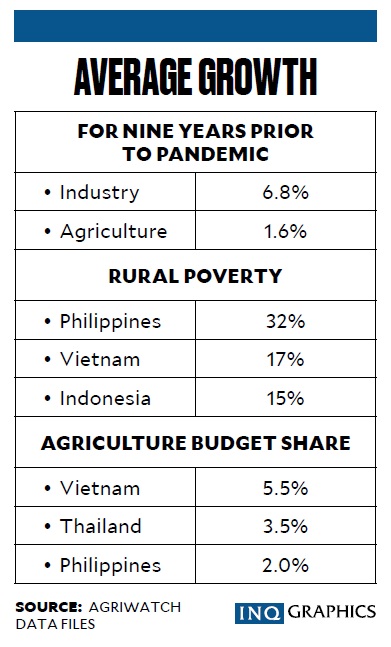Budget-strategy split spells failure
Just as structure should follow strategy, so should budget. Unfortunately, there is a split between the proposed Department of Agriculture (DA) 2022 budget and the new agriculture strategy unanimously approved by two separate assemblies last May. If this budget is not improved by Congress in the days ahead, we will likely fail to achieve a better agriculture future.
I had earlier written about a strategy of budget monitoring to prevent corruption at the DA. It included the reinstatement of a public-private sector structure—the Budget Committee of the legislated Philippine Council for Agriculture and Fisheries. When this committee was deactivated two years ago, the budget monitoring could no longer be done. It should be reinstated immediately so budget monitoring can be done systematically and effectively nationwide.
One conclusion from the recently released Commission on Audit report on DA 2020 spending is that there was corruption because of the alleged P22.7 billion in unliquidated or faulty documentation. In fairness, the DA may be correcting mistakes in this report soon. Some have happened at the provincial level, unknown to the head office. The public-private sector budget monitoring teams in the provinces could have prevented some of this.
Faulty budget
A more serious problem is not supporting a strategy with the appropriate budget, both in quantity and quality (See table).
As to budget quantity, our much lower agriculture budget share is a major reason why agricultural growth is low and rural poverty is high, compared to our neighbors in the region.
As to budget quality, we must focus on the most important priorities. These were identified by the DA and the private sector in the original, much larger DA budget proposal. However, the final administration submission was done with the input of the Department of Budget and Management (DBM). The private sector requested to participate in some DBM discussions so that it could better understand the real situation. This was denied, which hopefully should not happen in the future.
Recognizing our declining agriculture, President Duterte called for a May 18-19 National Food Security Summit with the theme: “Food for Today and Beyond – Transforming Philippine Agriculture.” This followed a May 14 National Farmer-Fisherfolk Congress, which concluded with 99 federations and organizations signing a “Unity Statement in Saving the Plunging Livelihood of Filipino Farmers and Fisherfolk and Addressing the Critical Situation of Philippine Agriculture and Food Security.” Both assemblies agreed on new common strategies needed for the desired agriculture transformation. Unfortunately, these new strategies are not supported in the the submitted DA 2022 budget proposal.
3 strategies
Here are some examples. There is the strategy of getting away from the monocrop culture in coconut, rice and corn farms that occupy more than 70 percent of our agricultural land. In many cases, adding high-value crops (HVC) can easily multiply farmer incomes by at least four times through inter, relay and additional cropping. Though at least a P10-billion budget is needed, the DA submitted a modest P5.1-billion HVC proposal. But the final submission to Congress was only P1.5 billion, even lower than the P1.7 billion given for this year. This will continue condemning many of our monocrop farmers to a life of poverty.
There is the strategy of empowering the local government units (LGUs) to effectively use their agriculture resources through capacity building. We saw how the devolved agricultural system was a dismal failure due to the absence of preparation and capacity building since the 1991 Local Government Code was implemented. This is specially important now because of the new Mandanas-Garcia ruling, which increases the LGU Internal Revenue Allotment by 55 percent to P234.6 billion. Again, there is hardly any budget for this. Therefore, our huge agriculture potential in the countryside will continue to be wasted.
Finally, there is the strategy of providing what is essential for achieving agricultural growth. This is the comprehensive market information system mandated by the 1997 Agriculture and Fisheries Modernization Act (RA No. 8435), but it was never implemented.
With this information system, we can now formulate effective roadmaps and plans. They are extremely inadequate today because of incomplete, conflicting and unreliable data. Again, there is no adequate budget. It is no wonder that, from being the best in agriculture in our region, we are now the worst, being the only net importer of food.
The final decision is now with the Senate and the House of Representatives. The farmer, fisherfolk and other agriculture stakeholders feel betrayed, with no budget provided for their unanimously approved new transformative strategies. Will Congress improve the currently defective DA 2022 budget proposal? If so, there will be hope for a new strategy that will give us the resurgent agriculture we need badly today. The author is Agriwatch chair, former Secretary of Presidential programs and projects and former undersecretary of DA and DTI. Contact is Agriwatch_phil@yahoo.com.
